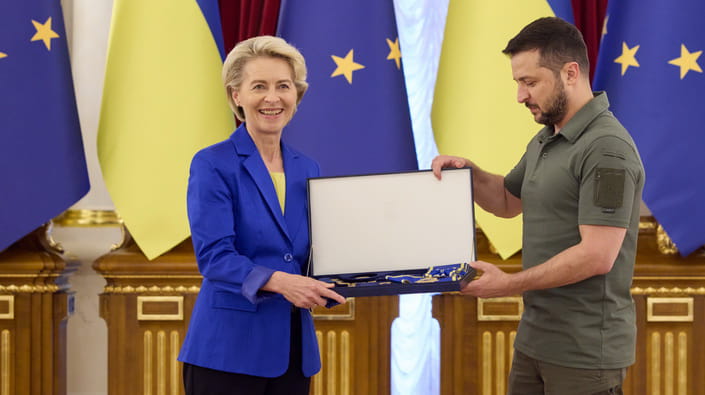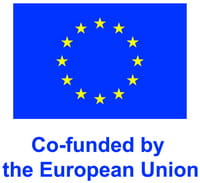Ukraine-EU Cooperation During the War: Synergy of New and Old Formats

One of the most common associations with the European Union is Eurobureaucracy and slow decision-making procedures. However, the rapid and rather decisive - despite the pressure of skeptical governments - the Union's response to the Russian Federation's aggressive war against Ukraine came as a surprise to many. It is not only about granting Ukraine the status of a candidate for EU membership, the introduction of eight rounds of sanctions against the Russian Federation and temporary protection in the EU for Ukrainians.
The arsenal of the Union's support for Ukraine also includes joint purchases of weapons, a military mission for the training of the Armed Forces, macro-financial assistance, the abolition of customs duties, "solidarity lanes" for the export of agricultural goods, assistance for the investigation of war crimes and plans for post-war reconstruction.
Finally, there are so many supportive initiatives and, accordingly, platforms for cooperation that urgent questions arise:
what role do pre-war cooperation formats play in wartime Ukraine-EU cooperation?
Does the Association Agreement remain relevant in the case of membership?
And how does the Ukraine-EU Deep and Comprehensive Free Trade Area (DCFTA) contribute to improving the climate for conducting business in Ukraine? How will the post-war reconstruction of Ukraine occur?
You will find the answers to all these questions in our today's material.
Reflection and deepening of the existing experience of integration
The formats of Ukraine-EU cooperation during wartime are, of course, largely determined by the needs of Ukraine. Thus, joint purchases of weapons through the European Peace Facility allow the Union member states to coordinate efforts to meet the needs of the Armed Forces on the battlefield.
The combination of measures to abolish customs duties for Ukrainian goods, strengthening the capacity of Ukraine-EU transport corridors and liberalization of transportation should help Ukraine economically. At the same time, "Solidarity Lanes" for Ukrainian goods are also a measure of economic security because they make Ukrainian exports at least partially independent of sea transport and the "grain initiative".
Besides the needs of the Ukrainian side, supportive initiatives from the Union, their contents and speed of implementation directly reflect the structure and dynamics of integration processes within the Union. Difficult political debates accompany foreign policy and security decisions, the conclusion of which requires the agreement of all member countries.
A vivid example is a process of making a decision to grant Ukraine the status of an EU candidate country, during which information about the fears and skepticism of individual states, such as the Netherlands and Denmark, appeared in the media at various stages. The process of agreeing on sanctions regarding the disconnection of part of the banks of the aggressor country from SWIFT, in particular, was not easy.
However, the initiatives that the European institutions can adopt independently on member states were adopted very quickly, and their spectrum indicates the involvement of all or almost all directorates of the European Commission and successful coordination between them.
Not the last role in this coordination is played by the Support Group for Ukraine at the European Commission, which acts as a connecting link between various EU structures that take care of cooperation with Ukraine
It is worth noting that the Support Group was created in 2014 - like many other integration formats of interaction between Ukraine and the EU. This directly illustrates our key thesis:
the European Union's wartime aid initiatives are largely based on the formats and mechanisms of interaction that existed before a full-scale invasion.
Quite provisionally, the formats of Ukraine-EU cooperation before the invasion can be divided into three categories: (i) political dialogue at different levels; (ii) interaction regarding the implementation of the Association Agreement, both formal - within the framework of the association bodies, and the development of informal professional networks and (iii) EU assistance projects, in particular, to finance fundamental political reforms: decentralization, public administration, as well as courts and the law enforcement system.
In addition, before the invasion, two missions of the European Union were already functioning in Ukraine, which took care of security issues: the EU Advisory Mission to Ukraine (EUAM) and the EU Border Assistance Mission to Moldova and Ukraine (EUBAM).
With the start of the full-scale war, many of these projects were reoriented to meet wartime needs. For example, the U-LEAD project on decentralization and regional development has begun to collect information on humanitarian needs among communities and distribute appropriate aid from the EU and member states. The mandate of the EUAM was supplemented so that the mission could support Ukrainian experts in the investigation of war crimes committed by the Russian Federation. So, one of the factors of the EU's rapid introduction of new initiatives in the field of state-building and security is the structures, funds, employees and networks of contacts that already functioned in Ukraine.
Association Agreement and new Economic initiatives
A similar transformation of "peaceful time European integration" into support in the context of war is taking place within the framework of the Ukraine-EU Association Agreement. As commonly known, the Agreement contains ambitious plans for the liberalization of trade in goods and services, as well as the sphere of public procurement. In April 2014, in the midst of the war in the east of Ukraine, which is three years before the entry into force of the Agreement, the European Commission had already decided on a temporary reduction or complete cancellation of tariffs on Ukrainian exports.
Annual cost savings for Ukrainian exporters at that time reached about 500 million euro. In 2022, the EU applied a similar instrument, but already as an addition to the rules and norms of trade liberalization within the framework of the DCFTA.
Significant volumes of Ukrainian exports to EU (prior to 2022 its general cost totaled 24.1 billion euro) and logistics challenges due to the invasion forced Ukraine and the EU seek for ways of further simplification of goods transportation. Among these it is necessary to single out liberalization of freight transportation by road, agreements for which were signed in June 2022. The Agreement allows Ukrainian carriers to fulfill bilateral and transit goods transportation without a permit.
At the same time, it is noteworthy that negotiations between Ukraine and EU on liberalization of transportation by different means of transport had been held since 2020 as part of broader negotiations on updating the Association Agreement. Despite a relatively low percentage of implementing by Ukraine its obligations according to the Agreement in the transport sphere (the aggregate indicator for 2015-2022 is 22 percent), certain fulfilled obligations in this sphere promoted a faster liberalization of transportation (for example, regarding the rules of transportation of dangerous goods).
Because of impossibility of using the Dnipro river as a transport artery due to combat operations and the occupation of the Kherson region, negotiations are being held from prospective of EU support of water transport development in Ukraine.
However, particularly ambition and detalization of the Agreement (e.g. in the part regarding the approximation of Ukrainian legislation to the norms of EU legislation) is a factor that will help Ukraine to move the negotiations step by step toward membership. In contrast to the Stabilization and Association Agreements with the Balkans, the EU-Ukraine Association Agreement contains a precise and accurate list of EU legislation acts which Ukrainian legislations strives to reach.
In certain spheres (technical barriers to trade, public procurement) Ukraine has fulfilled about 80% of its obligations.
Besides, the benefit of the Agreement is in existing structures platforms and networks for the dialogue in various sectors: from public procurement to environmental protection and sanitary and phytosanitary standards. Obviously, these formalized platforms (association bodies) and horizontal networks will make a "skeleton" for negotiations about enlargement
Another, less obvious factor is the connection between the FTAA and Ukraine's fulfillment of the political criteria necessary for membership in the Union. In its Opinion on Ukraine's membership application, the European Commission singled out several specific requirements for strengthening democracy and the rule of law.
The document specifies, in particular, requirements regarding the reform of the system of selection of judges to the Constitutional Court, the appointment of directors of the Specialized Anti-Corruption Prosecutor's Office (SAPO) and the National Anti-Corruption Bureau, legislation in the field of media and the rights of national minorities.
While the fulfillment of these requirements is related to the adoption and implementation of specific laws, the general political and institutional climate is also important. Its foundation is to some extent laid by the so-called non-trade objectives of the DCFTA. In addition to the purely trade-related regulations, the DCFTA contains many fairly specific standards in the area of the rule of law.
These are, for example, requirements for the publication of legislation, standards of accountability and transparency in the activities of governmental bodies, and guarantee for both foreign and domestic enterprises to access courts and arbitration, in particular, to protect companies from unfair competition and violations of intellectual property rights.
In addition, the DCFTA contains a call to the norms of the World Trade Organization (WTO), which are obligatory for the parties, which unify, for example, the requirements for the elimination of administrative barriers to trade.
Thus, the approximation of the institutional climate in Ukraine to the European one is not only the fulfillment of purely political requirements but also the full implementation of much deeper than purely trade norms of the FTAA.
Reconstruction prospects
Together with closely bound processes of implementation of the Association Agreement and negotiations about the future membership, in the nearest future restoration of the ruined infrastructure will become a vital part of the relations between Ukraine and EU.
The Candidate status is by no means a key political lever using which EU can influence the fulfillment of Ukraine its obligations on the Agreement and the framework of negotiations for membership.
The costs of reconstructing the ruined infrastructure objects, can become also a vital financial factor, especially in the context of European Green Deal (EGD). The main idea of EGD is to turning Europe into a climate-neutral continent by 2050.
Considering the aforementioned, a successful project of reconstructing Ukraine – which can take up to ten years (according to the EU leaders’ opinion) is both a financial lever of influence of EU on Ukraine and an initiative that demands the synergy of all existing formats and sectors. Without fulfilling the Association Agreement, especially in the environmental sphere it is difficult to speak about climate-neutral reconstruction and green energetics.
At the same time, as private funds will probably take part in the reconstruction, institutional climate and the progress of the Parties in the negotiations about membership will have a significant role as it will be considered by investors as a sign of predictability and stability. It is necessary to point out that the speed and success of reconstruction will also be affected by the stability and expansion of cooperation formats that were created during the war. There is considerable potential, in particular, in the preservation of automobile "Solidarity Lanes", as well as the wider use of rail and river transport.
Therefore, as in wartime, post-war Ukraine-EU cooperation will be characterized by the synergy of old and new formats, structures and networks, in which the Association Agreement will have a central role.

Maryna Rabinovych,
Senior Lecturer
Department of International Relations of the National University of Kyiv-Mohyla Academy
Coordinator of the Jean Monnet module INTEGTRADE
The material was created with the support of the European Commission as part of the Jean Monnet INTEGTRADE module, which is implemented by the Department of International Relations of the National University "Kyiv-Mohyla Academy".
